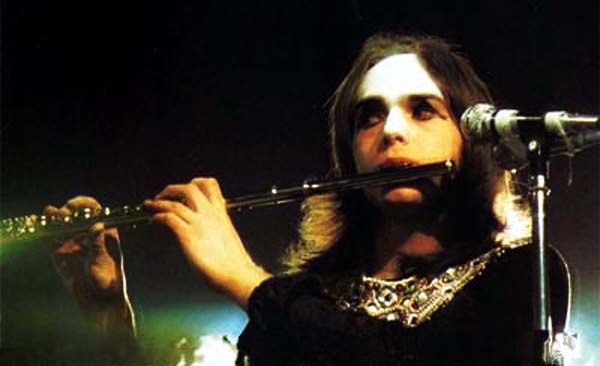When Peter Gabriel chose Scratch My Back as the title for his 2010 covers record, it was a dry joke — but also a statement of purpose. The liner notes of any Gabriel album teem with names drawn from across the worlds of rock, folk, jazz, and international music. And he has been generous with his time and talent in return. Over the next two Tuesdays we’ll be sharing a selective rundown of some of our favorite Gabriel guest shots.

Somewhat arbitrarily, I’m splitting Gabriel’s career into two parts, with the split falling roughly at the moment when he began to make the transition from pop star to icon, from a working musician to an institution.
Cat Stevens, “Katmandu” (from Mona Bone Jakon, 1970)
Mona Bone Jakon is a transitional record for Cat Stevens, immediately preceding the commercial and artistic breakthrough of Tea for the Tillerman; Gabriel has been dismissive of his own contribution to it, insisting it was limited to playing the flute “somewhat badly.” He’s heard most prominently on this track — although some of the backing vocals elsewhere on the record sound naggingly familiar…
Colin Scot, “Lead Us” (from Colin Scot, 1971, out of print)
For a while, Scot was pegged as the Next Big thing in British folk-rock. Alas, those expectations didn’t pan out. Which is a shame, because his debut album is a true lost classic, with an all-star cast including Gabriel, Robert Fripp, Jon Anderson, and the members of Van der Graaf Generator. They’re all in the chorus of this satirical anthem, written for Scot by frequent Monty Python collaborator Neil Innes.
Robert Fripp, “Here Comes the Flood” (from Exposure, 1979)
This haunting ballad first appeared — albeit in a very different arrangement — on Gabriel’s 1977 solo debut; but Gabriel was never happy with the heavy orchestration that producer Bob Ezrin had foisted upon the song, and seized the opportunity to rework it with Fripp’s ambient guitarscapes backing his voice and piano. It remains Gabriel’s preferred version — although in typically anti-commercial fashion, it would not be released under his own name until 1990, on the best-of compilation Shaking the Tree.
Johnny Warman, “Screaming Jets” (from Walking Into Mirrors, 1981)
English singer-guitarist Warman was working an arty / apocalyptic territory similar to Gabriel’s output at the time (albeit with a heavy dash of Gary Numan in the mix). Warman had hired Gabriel’s touring band to back him for his second solo disc, Walking Into Mirrors. Gabriel’s own contribution came on the spur of the moment — Warman reportedly wrote “Screaming Jets” in just 25 minutes, and you can hear him calling out the chords as the tape is rolling!
The Call, “Everywhere I Go” (from Reconciled, 1986)
There was a round-robin of guest appearances going around in 1985-86. First, the Call’s Michael Been and Jim Kerr of Simple Minds sang on Gabriel’s “In Your Eyes.” Then Gabriel and Kerr handled backing vocals on this mood piece. I love the way their voices blend, while remaining distinctly identifiable. The circle was never quite completed; although Been joined in the choir rave-up that closes “Sanctify Yourself,” Gabriel has, to my knowledge, never sung on a Simple Minds record, and any chance of another three-way vocal jam ended with Michael Been’s death in 2010.
Robbie Robertson, “Broken Arrow” (from Robbie Robertson, 1987)
If you’ve seen The Last Waltz, you know that Robbie Robertson’s got a pretty deep Rolodex; his debut solo record was always going to be a star-studded affair. Robbie Robertson‘s guest players, mostly recruited by producer Daniel Lanois, included U2, the BoDeans, Maria McKee, and members of the Neville Brothers. Gabriel, another Lanois client, lends his rhythm section of Tony Levin and Manu KatchÁ©, and guests on two songs himself. Gabriel’s vocal cameo on “Fallen Angel” is a misfire — obvious and gimmicky — but the thundering piano of “Broken Arrow” (which was later a big hit for Rod Stewart) is a reminder of what a fine and distinctive keyboardist he is; listen for his entrance about a minute in.
Nona Hendryx, ”Winds of Change (Mandela to Mandela)” (from Female Trouble, 1987, out of print; re-released on Transformation: The Best of Nona Hendryx)
This track encapsulates a particular moment in late-80s pop. Post Live Aid, post-Conspiracy of Hope, post-”Sun City” (kids, ask your parents), musicians felt it was incumbent on them to display publicly the social consciences they may have previously kept private. That’s why the great R&B unclassifiable Nona Hendryx (formerly of LaBelle) felt the need to interrupt the club jams of Female Trouble for this odd, vaguely political ballad. And it’s why Gabriel is here, too; it was customary to invite other musicians to share in those expressions of conscience. In fact, for a while it was expected that guest appearances could not simply be fun, but that they had to be important events. (Seriously. I remember reading a lot of verbiage laying out how Stevie Wonder blowing harp on a Eurythmics track represented some kind of intergenerational passing of the torch for the very concept of soul music, instead of just being a bunch of musicians getting together to do what they love. The 80s were weird, man.)
(Also very much of its time: the notion of Winnie Mandela as any kind of heroic figure.)
More next week, as Gabriel becomes an impresario, guru, and inspiration for a new generation of artists.
Related articles
- Listening booth – Peter Gabriel at Rock Werchter, 1983 (grayflannelsuit.net)
- Here’s Something Else!: Genesis That Doesn’t, You Know, Suck (popdose.com)






Comments